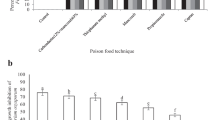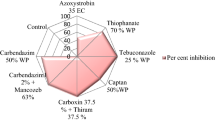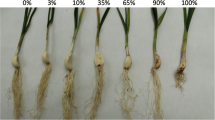Abstract
The research was conducted to evaluate in-vitro efficacy of numerous fungicides against Fusarium oxysporum f. sp. capsici. In present research, six treatments (T) viz. Carbendazim, Benomyl, Topsin-M, Difenoconazole, Nativo, and Alliete along with control, various concentrations (C), days (D), and their interactions, i.e., (T × C), (T × D), (C × D), and (T × C × D) were exploited in a laboratory through food poison technique. Alliete expressed maximum colony growth (1.93 cm) as compared to all other fungicides with respect to control. Interaction between treatments and concentration (T × C) exhibited maximum colony growth of all treatments (Carbendazim, Benomyl, Topsin-M, Difenoconazole, Nativo, and Alliete), i.e., 0.87, 1.23, 1.73, 2.20, 2.53, and 2.93 cm at 300 ppm as compared to 500 and 700 ppm concentrations, respectively. Similar trend was also observed concerning interaction between (fungicides × days) and (tested concentrations × days). Results of the present study revealed that among tested fungicides, Carbendazim at 700 ppm expressed significant reduction in fungal growth.

Similar content being viewed by others
References
Abd-Allah EF, Hashem A, Al-Huqail A (2011) Biologically-based strategies to reduce postharvest losses of tomato. Afr J Biotechnol 32:6040–6044
Abdel-monaim MF (2012) Induced systemic resistance in tomato plants against Fusarium wilt diseases. Int Res J Microbiol 3:14–23
Amini J, Sidovich DF (2010) The effects of fungicides on Fusarium oxysporum f. sp. lycopersici associated with Fusarium wilt of tomato. J Plant Prot Res 50(2):172–178
Bilgrami KS, Dube HC (1976) A textbook of modern plant pathology. Vikas publishing house, New Delhi, p 344
Diaz J, Silvar C, Varela MV, Merino F (2005) Fusarium confers protection against several mycelial pathogens of pepper plants. Can J Plant Pathol 54:773–780
El-Kazzaz MK, El-Fadly GB, Gan HME-K (2008) Identification of some Fusarium spp. using molecular biology techniques. Egypt J Phytopath 36(2):57–69
Ignjatov M, Milosevic D, Nikolic Z, Gvozdanovic VJ, Jovicic D, Zdjelar G (2012) Fusarium oxysporum as causal agent of tomato wilt and fruit rot. Pestic and Phytomed. 27:25–31
Iqbal Z, Pervez MA, Ahmad S, Iftikhar Y, Yasin M, Nawaz A, Ghazanfar MU, Dasti AA, Saleem A (2010) Determination of minimum inhibitory concentrations of fungicides against fungus Fusarium mangiferae. Pak J Bot 42(5):3525–3532
Irum M (2007) Comparison of phytochemical and chemical control of Fusarium oxysporum f. sp. cicera. Mycopathologia 5(2):107–110
Kamal AM, Elyousr A, Hashem MM (2009) Biological control of Fusarium wilt in tomato by plant growth promoting yeasts and rhizobacteria. Plant Pathol J 25:199–204
Madhavi GB, Bhattiprolu SL (2011) Evaluation of fungicides, soil amendment practices and bioagents against Fusarium solani-causal agent of wilt disease in chilli. J Hort Sci 6(2):141–144
Magnucka EG, Suzuki Y, Pietr SJ, Kozubek A, Zarnowski R (2007) Action of benzimidazole fungicides on resorcinolic lipid metabolism in rye seedlings depends on thermal and light growth conditions. Pestc Biochem Phys 88:219–225
Matthew A, Lawal A, Chindo P, Olaleka NB (2006) Outbreak of basal stem rot and wilt disease of pepper in northern Nigeria. J Plant Prot Res 46(1):7–14
Morid B, Hajmansoor S, Kakvan N (2012) Screening of resistance genes to Fusarium root rot and Fusarium wilt diseases in tomato (Lycopersicon esculentum) cultivars using RAPD and CAPs markers. Eur J Exp Biol 2:931–939
Mushtaq M, Hashmi MH (1997) Fungi associated with wilt disease of capsicum in Sindh, Pakistan. Pak J Bot 29(2):217–222
Naik MK, Madhukar HM, Devika Rani GS (2007) Evaluation of fungicides against Fusarium solani, the causal agent of wilt of chilli. Veg Sci 34:173–176
Omar I, O’Neill TM, Rossall S (2006) Biological control of Fusarium crown and root rot of tomato with antagonistic bacteria and integrated control when combined with the fungicide carbendazim. Plant Pathol 55(1):92–99. https://doi.org/10.1111/j.1365-3059.2005.01315.x
Parsa S, Sahi ST, Jabbar A, Rehman A, Riaz K, Hannan A (2013) Chemical and biological management of Fusarium oxysporum f. sp melongenae. Pak J Phytopath 25(2):155–159
Penchala RG, Ramakrishna Rao SV, Gopal K (2008) In vitro evaluation of antagonists and fungicides against the red gram wilt pathogen Fusarium oxysporum f. sp. udam (butler). Legume Res 31:133–135
Ragab MMM, Ashour AMA, Abdel-Kader MM, El-Mohamady R, Abdel-Aziz A (2012) In vitro evaluation of some fungicides alternatives against Fusarium oxysporum the causal of wilt disease of pepper (Capsicum annum L.) Int J Agric and Fores 2(2):70–77
Sarwar N, Zahid MH, Haq IU, Jamil FF (2005) Induction of systemic resistance in chickpea against Fusarium wilt by seed treatment with salicylic acid and bion. Pak J Bot 37(4):989–995
Shah N, Rehana NS, Anam M, Khanzada M, Khanzada MA, LodhI AM (2014) Influence of different inoculation methods and fungicides on the pathogenicity of Fusarium oxysporum on Abelmoschus esculentus L. Forensic Sci Int 26(5):2303–2308
Sitara U, Hasan N (2011) Studies on the efficacy of chemical and non-chemical treatments to control mycoflora associated with chilli seed. Pak J Bot 43(1):95–110
Soesanto L, Utami DS, Rahayuniati RF (2011) Morphological characteristics of four Trichoderma isolates and two endophytic Fusarium isolates. J Sci Ind Res 2(8):294–306
Song W, Zhou L, Yang C, Cao X, Zhang L, Liu X (2004) Tomato Fusarium wilt and its chemical control strategies in a hydroponic system. Crop Protect 23:243–247
Steel RGD, Torrie JH, Dickey DA (1997) Principles and procedures of statistics. A Biometrical Approach, 3rd edn. McGraw Hill Pub. Co., New York
Tariq RR, Razdan VK, Tewari AK, Shanaz E, Bhat ZA, Hassan MG, Wani TA (2012) Integrated management of wilt complex disease in bell pepper (Capsicum annuum L.) J Agric Sci 4(7):141–147. https://doi.org/10.5539/jas.v4n7p141
Weitang S, Ligang Z, Chengzong Y, Xiaodong C, Liqun Z, Xili L (2004) Tomato Fusarium wilt and its chemical control strategies in a hydroponic system. Crop Protect 23:243–247
Yucel S, Elekcioolu YH, Can C, Soout MA, Ozarslandan A (2007) Alternative techniques to control wilts in vegetables. Turkish J Agric 31:47–53
Acknowledgements
The current research is a part of Ph.D. degree; the author acknowledges both Dr. Muhammad Atiq, Assistant Professor of the Department of Plant Pathology, and Prof. Dr. Shahbaz Talib Sahi of the Department of Plant Pathology for their supervision, valuable suggestions, and cooperation throughout this work.
Author information
Authors and Affiliations
Corresponding author
Additional information
Responsible editor: Philippe Garrigues
Rights and permissions
About this article
Cite this article
Bashir, M.R., Atiq, M., Sajid, M. et al. Antifungal exploitation of fungicides against Fusarium oxysporum f. sp. capsici causing Fusarium wilt of chilli pepper in Pakistan. Environ Sci Pollut Res 25, 6797–6801 (2018). https://doi.org/10.1007/s11356-017-1032-9
Received:
Accepted:
Published:
Issue Date:
DOI: https://doi.org/10.1007/s11356-017-1032-9




